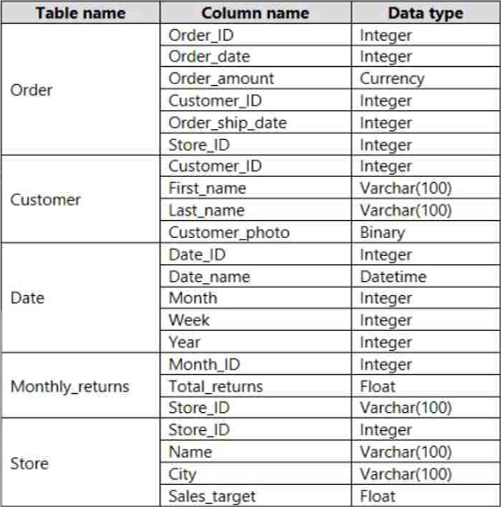Note: This question is part of a series of questions that use the same scenario. For your convenience, the scenario is repeated in each question. Each question presents a different goal and answer choices, but the text of the scenario is the same in each question in this series.
Start of repeated scenario
You have a Microsoft SQL Server database that contains the following tables.

The following columns contain date information:
• Date[Month] in the mmyyyy format
• Date[Date_ID] in the ddmmyyyy format
• Date[Date_name] in the mm/dd/yyyy format
• Monthly_returns[Month_ID] in the mmyyyy format
The Order table contains more than one million rows.
The Store table has a relationship to the Monthly_returns table on the StoreJD column. This is the only relationship between the tables.
You plan to use Power B! Desktop to create an analytics solution for the data.
End of repeated scenario.
You need to create a chart that displays a sum of Order[Order_amount] by month for the Order_ship_date column and the Order_date column.
How should you model the data?
A . Add a second Date table named Ship_date to the model. Create a many-to-many relationship from Date[Date_ID] to Order [Order_date] and a many-to-many relationship from Ship_date[DateJD] to Order[Order_ship_date].
B . Add a second Date table named Ship_date to the model. Create a one-to-many relationship from Date[Date_ID] to Order [Order_date] and a one-to-many relationship from Ship_date[Date_ID] to Order[Order_ship_date
D . Create a one-to-many relationship from Date[Date_ID] to Order[Order_date] and another relationship from Date[Date_ID] to Monthly_returns[Date_ID
F . Create a one-to-many relationship from Date[Date_ID] to Order[Order_date] and another relationship from Date[Date_ID] to Order[Order_ship_date].
Answer: D

Leave a Reply